How to Tell If a Cat Is Dehydrated
Cat Dehydration and Drinking Problems
Doc Truli stood over a dehydrated, lethargic, sick-looking seal-point Siamese cat named Archie, who did not possess the willpower to meow. (Can you see the signs of cat dehydration in Archie’s picture?)
“I think he ate a lizard,” said Archie’s mom.
“That’s normal,” said Doc Truli. “What’s very concerning is the dehydration.”
“My cat is drinking so much, how could he possibly be dehydrated?” said Archie’s mom.
Dehydration in a Cat Can be Difficult to Distinguish
In the face of evidence of dehydration most people cannot believe their cat suffers dehydration, usually because the cat drinks so much water!
4 Symptoms of Dehydration in a Cat
- sunken eyes
- dry, tacky gingiva that your finger sticks to when you feel your cat’s gums
- fur standing up in clumpy shelves of gloppy unhealthiness
- glazed stare at the bathroom water spigot
“But he urinates a lot,” most cat moms insist.
(Perhaps at this point, the obviousness of the conclusion overwhelms people, and rampant guilt takes over.)
Veterinarians Use the Skin Turgor Test for Dehydration
The final, definitive physical test for dehydration in a cat is the skin turgor test. Turgor refers to the rigidity of the skin. Normally skin will bounce back flat just after being released from a pinch. Decreased collagen with aging will also cause a delayed bounce-back, but this is much less pronounced in cats. If you are unsure when pinching the neck skin, try the skin over the mid-back and haunches to be sure. (Do not get bit!)
Practice the Skin Turgor Test on Your Own Hand: Maybe You Can Tell How Long You Might Live!
First, practice on the back of your hand. If you are under age 50, you most likely have plenty of collagen left in your skin. So you pinch the skin on the back of your hand and notice how quickly the skin goes back down. Should be immediate!
At a recent conference focused on aging in people and pets, the presenter told the veterinarians in the audience to do this test on their own hands. The presenter said,”The longer your skin stays tented up, the less time you have left!”
Seconds later, a colleague from the front of the lecture hall said,”Oh, sh*t!” Doc Truli is happy to report the colleague is alive and well; specialists do not know everything!
Perform the Skin Turgor Test on Your Cat
Now test your cat. Here’s how to do a skin turgor test for dehydration on your cat:
- gently pinch some skin on the back of the neck/shoulder area.
- If the skin stays up and does not go down, your cat is so severely dehydrated you have to get to a veterinarian urgently.
- If the skin takes a second or two to go down, you have to go to the vet’s because of moderate to severe dehydration.
- If your cat’s skin snaps back in place, you annoyed your cat with the test, fur is thick and shiny, and your cat is lively and happy, why are you reading this? Prepare a cup of organic green tea and leave your cat alone!
Moderate to Severe Dehydration Requires Hospital Care
Archie’s skin formed a leathery, furry brown ridge along his back. The skin never went back down.
“I can give him more water. Should I offer him wet food?” said Archie’s mom. (Most people ask this same question.)
Doc Truli said,”Archie is gravely ill. This severity of dehydration, even if the original cause was simple and fixable, has advanced. Rehydration involves much more than pouring liquid into his body.”
“How could this be, he drinks all the time,” lamented mom.
Here’s the VirtuaVet scoop on dehydrated cats who drink water like crazy:
If you cat drinks a ton of water, yet still shows symptoms of dehydration, then the fluid homeostasis of the body is not functioning properly. This means the liver, or kidneys, or brain, or a disease like diabetes mellitus, is driving your cat’s body to kick out too much water. This is unhealthy and unnatural, of course.“You cannot fix metabolic, neoplastic, or toxic dehydration by throwing more water at the problem!” says Doc Truli.
“Why Does My Cat Have to Stay in the Hospital?”
The next question almost every cat parent asks: “Oh, does he have to stay overnight?”
“Rehydration involves providing intravenous fluids slowly over time to rehydrate and balance your cat’s internal functions. The rehydration cannot occur in just minutes or hours, because the volume of fluid required to rehydrate a cat like Archie is considerable,” says Doc Truli.
Gradual Rehydration Spares Stress on the Heart
If you suddenly added several liters of blood into your veins and arteries, do you think your heart would like the extra work? No! Your heart would probably become congested and over-worked, then your lungs would fill up with the extra liquid and you would drown from congestive heart failure. Cats are the same as people.
Sample rehydration calculations:
Archie weighs 4.5kg (10lb). Archie is about 10% dehydrated. (You die around 10-12% dehydrated.). About 70% of his weight should be water. For rough estimating, he is about 0.5 kilogram short on water! Usually, Doc’s cat patients will gain about a pound of water weight after 24 hours of rehydrated. That’s like a 75 kg person (150lb) gaining about 7kg or 15 pounds! How do you think your heart would respond to an extra 7 kg/15 lbs of liquid to push around? Not good! This much rehydrated takes physical, mechanical adjustments in the body.
Rehydration Allows Rebalancing of all Bodily Functions
The liquid going into Archie’s veins needed to re-equilibrate with the interstitium between his cells.
“What?” (you might be thinking.)
(Doc Truli doesn’t talk like this in person, but you’re reading this to learn more details.)
Basically, the electrolytes — sodium, potassium, and chloride — proteins, tiny molecular factors, inflammatory chemicals, bodily waste products, etc swap out of the cells and on their way to excretion through the lymph and blood. The intravenous liquid going into Archie’s veins stays there a few minutes. A process of swapping toxic waste by-products from inside the cells to the interstitium surrounding the cells accelerates due to the infusion of intravenous liquid.
- The lymph and blood circulation carries the waste and toxic substances of the body to the liver, kidneys, spleen, lungs, and skin, where they are excreted in many forms.
- The liver produces bile to excrete toxins.
- The kidneys filter toxins out of the blood.
- The spleen grabs bacteria, parasites, and damaged, old cells out of circulation and repackages them into non-toxic proteins, or walls them off for storage.
- The lungs breathe out toxins.
- The largest organ of the body — the skin — releases toxins through sweat and excretion onto the surface of the skin.
Cellular functions improve and healing begins when intravenous fluids jump-start the complicated and natural process of healing.
If someone is visibly 10% dehydrated, you can bet this swapping out, housecleaning process will take *at least* 24 hours. Every cat differs and every disease condition sets the recovery speed individually. That’s why Archie stayed in the hospital a few days.
Helping Diagnose and Treat the Underlying Reasons for the Dehydration Allows a Return to the Home Environment
Archie the cat suffered hyperthyroidism, hypertension, and Iris classification 3 kidney insufficiency. With treatment and intravenous fluids, his renal problems improved enough to become a Grade 2, which is stable but not normal, the hyperthyroidism is controlled with medication and the hypertension resolved over two months of medication and sorting out the other problems.
Because of optimism, persistence, and financial ability, Archie continues to enjoy chasing lizards on the screened lanai porch!
Cat Dehydration Self-Quiz and Gallery
This is Archie. He is probably the most dehydrated cat Doc Truli has ever seen still living and breathing. Notice the skin folds after the turgor test? Most cats will have a few seconds delay on the folds going away, but they will smooth out. Archie’s folds never smoothed out!
Sammy was a little sick. He was medium-dehydrated. About 4-6%. He got sick after eating spoiled cat food and after a night on intravenous fluids, he felt new again.
Precious suffered from kidney disease. She was very sick by the time her family realized. Notice how she sits in the hunched position that indicates pain and discomfort in cats? Plus, if you followed the twitter feed to the mouse pain article, you’ll recognize the cheek bunching and squinting that human babies, mice, and cats show when they are is discomfort or pain. With renal specific diet changes and treatment, Precious is still doing well.
Ralph suffered liver cancer. It hit him all of a sudden and he passed away a short time after he was hospitalized. His folks chose Pawspice care, instead of invasive liver surgery which had a very poor chance of helping him live longer anyway. Doc Truli heard he had filet mignon for his last meal. Sometimes home care is the right way to go. For more information on hospice for pets, visit VirtuaVet’s pages about Pet Quality of Life.
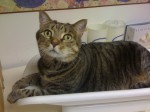
King: Clear, plump bright eyes and smooth soft fur = well hydrated cat. Can you just see the difference?
King was a healthy, strong cat. You can see how bright and lively his eyes look compared to a dehydrated sick cat in pain.
Doc threw this picture in there to test if you are awake! Max was a fat, sassy guy. He’s going to star in a cat obesity story one of these days. However, he’s not “stuffed,” like a stuffed toy, Max is hydrated. Notice the shiny, smooth fur that is sleek and elegant to the touch.
Okay, the final exam on cat dehydration. This is VirtuaCat just after VirtuaVet shaved him! VirtuaCat is a Seal-Point Himalayan. Notice the folds of skin behind his elbow. Do you think he is dehydrated? If you answered “no!” you are correct.
What’s the deal? Certain breeds of cats have different skin from other cats. Especially Hairless Cats, Himalayans, Persians, and many others. VirtuaCat’s skin is softer and more flexible, with extra droopy folds behind his arms, and sagging down from his gut, even though he has never been fat! Everything is in the experience and the interpretation.
If you suspect dehydration in your cat, visit your veterinarian to be sure!
Final FAQ: IS dehydration painful?
Yes! It’s also a major cause of headaches in anyone consuming a “modern American diet.”

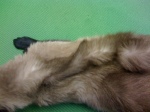
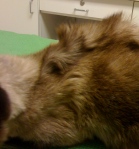
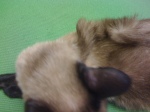

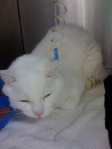
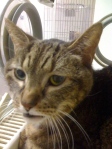
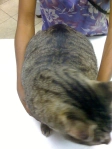



Thanks for posting this very valuable piece of information. My 2 year old female kitty has been diagnosed with advanced stage, effusive FIP. I found out that sending her to the vet for Sub-Q fluid infusion somewhat re-energizes her into mild remission.
She is drinking on her own, but apparently not enough to combat her severe dehydration. My cat now looks like poor Ralph in one of the photos above, only much worse. She is now on Baytril antibiotics, a small dose of prednisone and ranitidine to reduce her nausea and inappetance.
My cat is strong willed but unfortunately her organs are failing her. I would wet her fur with some surgical alcohol (70% volume) to cool her down whenever her temps are above the norm. I do have some leftover meloxicam in case she needs it badly for high fever, but restrained from giving her for fear of damaging her kidneys any further.
I’m sorry to hear about your kitty’s illness.
For appetite stimulation and as an anti-depressant, ask your veterinarian about mirtazipine. It is cleared through the liver, and FIP reduces all organ functions, and in an unpredictable individual way, but the mirtazipine is a good appetite stimulant and an anti-depressant. It could help her feel better. I also use injectable midazolam for appetite stimulation in cats. It’s related to valium and gives cats the munchies. Unfortunately, no pill form, but sometimes you can learn to give the doses at home.
Yours,
Doc Truli
Dear Doc Truli, here’s my dilemma:
I’ve resigned to my cat’s inevitable fate and accepted the fact that contemporary veterinary medicine cannot cure FIP. However it is quality palliative care that I’m concerned about.
My vet is adamant against any kind of benzodiazepine, citing possible impairment of kidney or liver functions, especially in my cat’s condition.
I asked for a liver enzyme count but she said that her CBC procedure did not involve liver enzyme diagnosis. She is a fairly young VMD (in her mid 20s) and I sensed that she had little experience with giving even diazepam as an appetite stimulant. (I know this for sure, as I had been on diazepam before and does increase my appetite).
Suffice to say, if she wouldn’t give something as “mild” as diazepam, midazolam would would be totally out of the question. I doubt the animal hospital carries midazolam anyway.
I have tried giving my cat cyproheptadine/L-lysine drops to increase her appetite but stopped upon the advice of the vet. I noted all the signs of nausea in my cat but so far she has never vomited bile.
Force feeding Hill’s A/D prescription formula is something that neither my kitty or I enjoy. In fact, feeding time has become a very stressful event!
I have watched her eat flaked white tuna on a few occasions but stopped after the first few sips/mouthful. Probably due to her discomfort and nausea. What can I do? I have alprazolam (Xanax) at my disposal but don’t know the right dosage to give to my cat.
Would alprazolam be a good substitute for diazepam in cats? I’ve sneaked in about 0.25mg into her food once and noted no ill effects (none yet so far). But I observed that on the same day, she developed an interest in the same food that she used to love.
Currently, my Baby Kat is on the following:
– Hill’s A/D prescription diet (sometimes mixed with tuna for flavor)
– Felovite with Taurine multi-vitamin oral paste
– Baytril antibiotic for the blood parasites
– Prednisone corticosteroid as an anti-inflammatory agent
– Ranitidine for her acid reflux/nausea
I know about Remeron (mirtazapine) as I’ve been prescribed them before for my own illness, (currently on Lamictal and Cymbalta a.k.a duolexetine).
If I were to ask for mirtazapine, midazolam or diazepam for my cat’s inappetance , what would the safest dosage be? My cat weighs under 4 kgs at the last weigh-in at the regular vet’s.
thanking you in advance!
Q.
Q-
I do not know your cat’s condition, because I’m not there. If your vet feels a drug is contraindicated, perhaps it is!
Midazolam is not diazepam. Diazepam has been shown to cause idiosyncratic irreversible liver necrosis in cats. No one knows why or which cats. Midazolam has not done this. I use midazolam as an anti-anxiety med with almost every cat surgery I have done for the past ten years. It makes the cats so munchy, they will eat right after surgery if I give them a chance! It is super short acting in most cats, so the bowl of food must be right under their noses after the shot. You are following your veterinarian’s guidance, which is great. I can tell you, I never used midazolam for cats until I was about 3 years out of school and called the pharmacology professors at several North American veterinary colleges until I felt comfortable trying the midazolam.
The alprazolam you’ve given could cause liver and kidney damage, too. (All drugs have unwanted side effects with the wanted effects; it’s a trade-off). By giving your cat meds without your vet’s advice, you are experimenting on your kitty. Do you want to do that? BTW Alprazolam is not known to have any appetite stimulant effects in cats.
I can’t ethically give you medication doses for a cat who is not directly my patient! (That’s why you can’t find doses on the internet.) You could really damage your kitty’s quality of life that way. Your veterinarian has specialists at her fingertips. If you are gently persistent in your concerns for your kitty’s appetite and keep questioning whether or not everything is done for her comfort, your vet can keep researching and gathering ideas for how to best help your kitty.
Try not to become adversarial with your veterinarian, it doesn’t help anybody. FIP is a terrible disease. There is not one “right” course of action. The regimen you listed above sounds good. There was one other thing I thought of that could help appetite and digestive health, Vitamin B12 injections. Veterinarians have started adding B12 injections to very sick kitties’ treatment and it helps them feel better. Make no mistake, however, FIP is vicious. Just do the best you can!
Good Luck!
Doc Truli